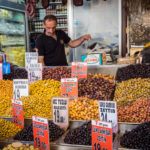Madrid Food Guide: Learn What To Eat In Madrid Spain. As a capital, Madrid offers an extensive variety of both Spanish and world cuisine. In this article, we’ll focus specifically on authentic, Madrid traditional food, the best Tapas in Madrid and a quick look at some incredible contemporary Spanish cuisine you have to try.
Also in this article, we check out some of the best Madrid experiences. We review a very special dining experience as we visit a Flamenco Restaurant in Madrid, and we take a Madrid food tour to discover Madrid street food, traditional drinks, history and a lot more.
Planning and trip to explore Spain and ready to learn what to eat in Madrid & where to eat in Madrid? Great! Let’s Do it.
Madrid Food Guide: What To Eat In Madrid Spain (Table Of Contents)Flamenco Restaurant Madrid: Corral de la Morería What To Eat In Madrid: Podcast Tapas Madrid: Snacks, Street Food, Starters & Tapas Madrid Food Guide: Hearty Dishes / Mains What To Eat In Madrid: Sweets, Desserts & Drinks Madrid Accommodation (Opens In New Tab): Booking.com | Agoda | Hotels.com | Airbnb (Get $25 Credit) Disclaimer: This article contains revenue generating links. Please support our blog by making bookings through our links & ads, rather than searching our suggestions on google. Some experiences/food mentioned here were provided to us complimentary for review purposes. Our opinions are our own and we provide an honest review, not an advertorial. |
Madrid is, of course, the capital of Spain, and has been continuously since 1606. It’s located in the heart of the Iberian peninsula, right in the center of Spain. As the capital of one of the most influential food countries in history, Madrid Food features some familiar classics that have spread worldwide, as well as some local surprises and twists that offer unique flavor to the traveling foodie.
First up in our Madrid Food Guide, some unique food experiences.
Flamenco Restaurant Madrid: Corral de la Morería
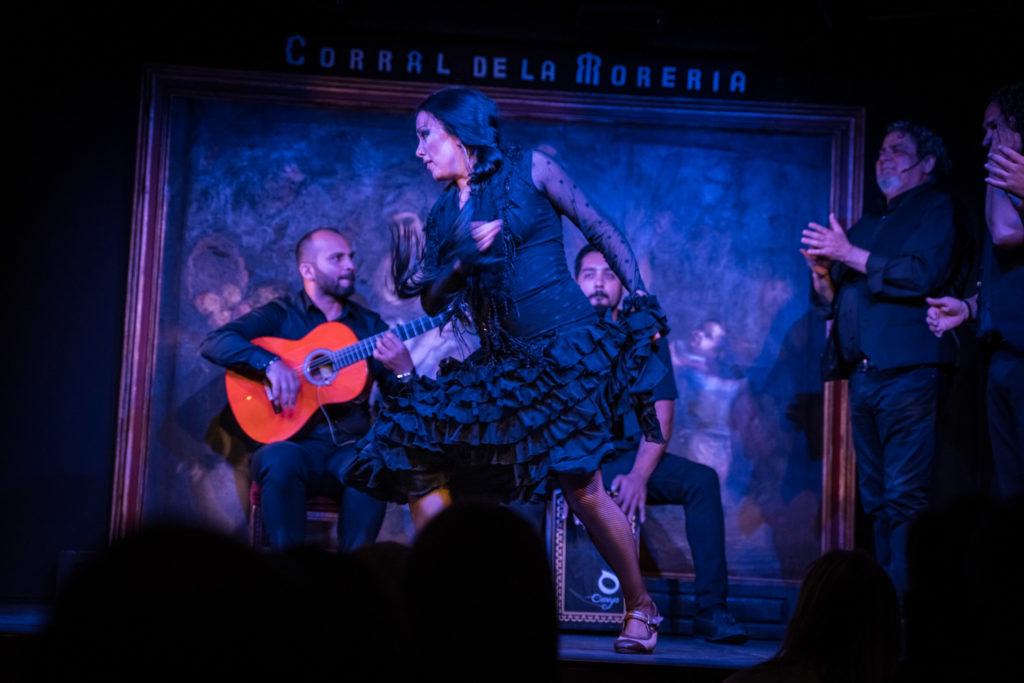
Madrid Food Guide | Flamenco Restaurant Madrid: Corral de la Morería
One of the best eating experiences in Madrid is a flamenco dinner show. We headed to Corral de la Moreria where Haute cuisine meets traditional flamenco in an always busy, intimate venue.
Of course, it’s not simply about the incredible flamenco dancing, but also about the food.
Chef David García gained a Michelin star as head chef at restaurant Álbora in 2014. To move to the next level, as if that wasn’t already impressive enough, Chef Garcia wanted to combine the emotion of food with the powerful emotion of Flamenco, for an unbeatable emotive experience.
Flamenco really does exude raw passion in a way other dance forms don’t. It’s respectably sensual. Just like the food here.
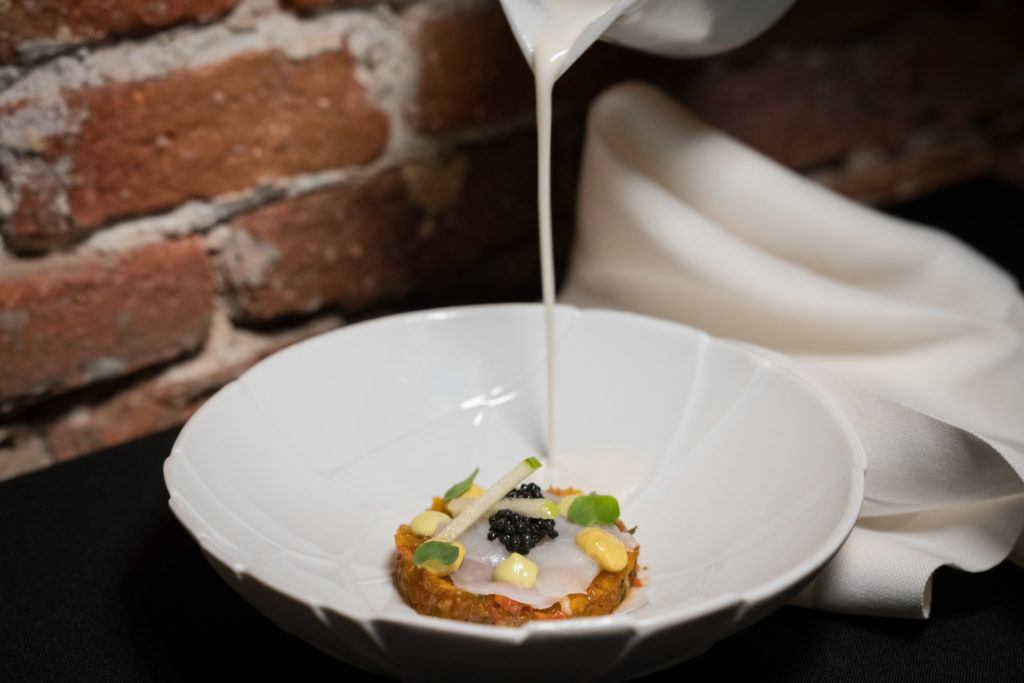
What to eat in Madrid: Scallop Carpaccio with Tomato Tartare
The cuisine at Corral de la Moreria is focused on organic ingredients and exciting combinations. The Scallop Carpaccio with Tomato Tartare, Dates and Cold Garlic, served with an Almond and coconut milk Soup which is poured on top of the carpaccio at the table.
WOW. Mouth explosion. This dish reflects the sophisticated passion of the Flamenco. The tomato really pops the rest of the flavors of the dish. My number one plate of the night.
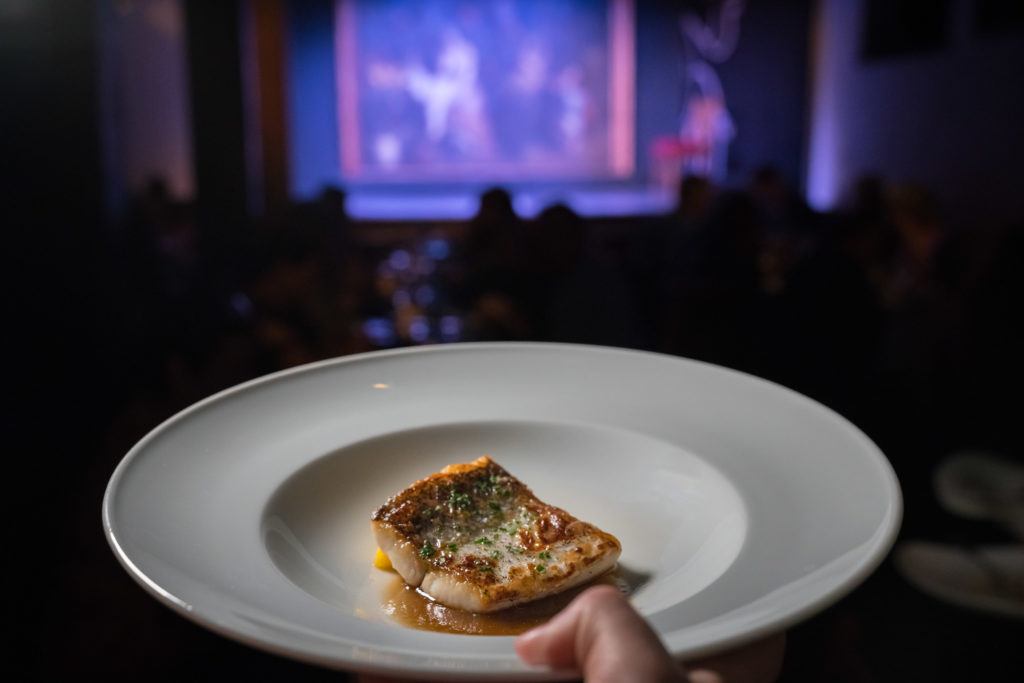
Roasted Hake with root vegetable purée and mushroom & lemon Consommé @ Corral de la Morería)
This is not your typical food in Madrid. It’s next level stuff.
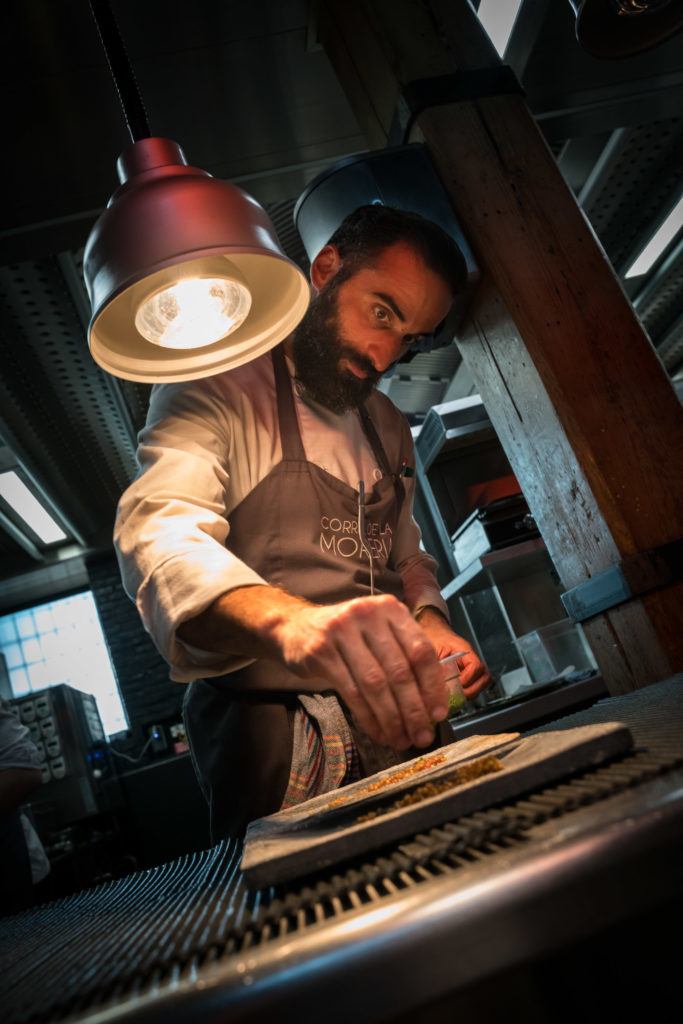 In The Kitchen |
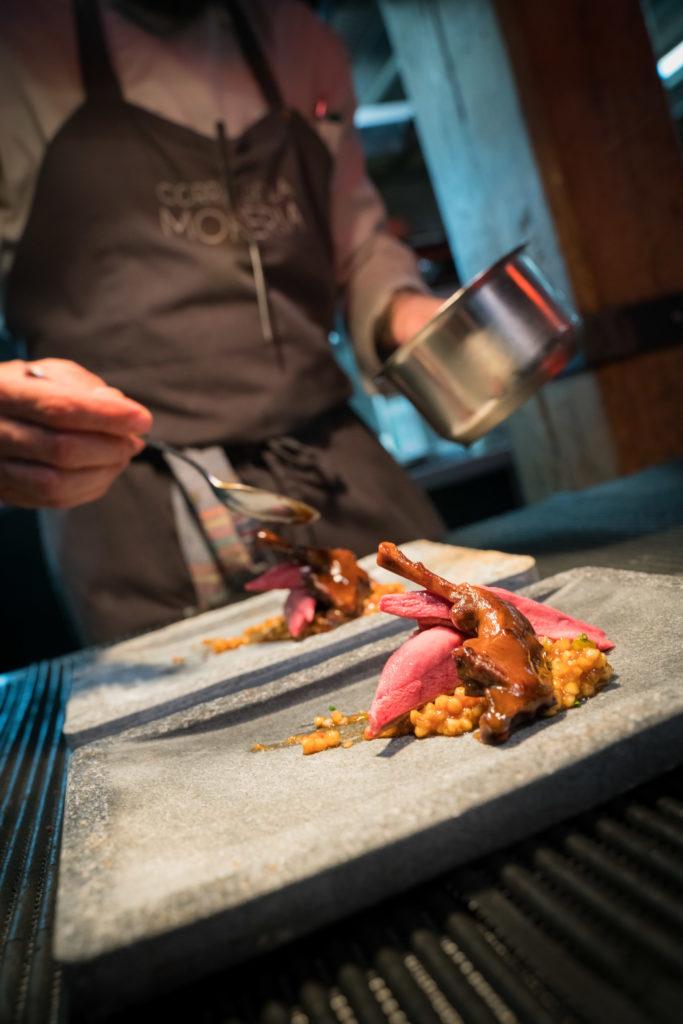 Pigeon cooked 2 ways |
We loved every course, but the other star dish was the Pigeon in two cooking styles with soft Buckwheat Risotto. Confit pigeon leg, along with seared, rare pigeon breast. Rich yet delicate meat. The pigeon breast simply melted away on the tongue. A must eat in Madrid.
Another dish that was incredible, but impossible to make look pretty in a photograph, was the walnut paste dessert. They make this tasty walnut paste, put it in a vacuum so it expands into something resembling very airy bread, then they freeze it in that state. You get served this block of airy dough on the plate, which slowly begins to sink back into a paste. It tastes so good! And was a super interesting concept.
Where to eat in Madrid? Have a night to remember at Corral de la Morería Flamenco Restaurant Madrid. Reservations essential.
Madrid Food Tour
Taking a Madrid food tour is the ideal way to get the culinary lay of the land very quickly. It’s the fast track to getting a taste of the food culture – and a lot of bites of the food itself. Your local Madrid food guide helps you avoid the tourist traps and discover some truly authentic place to eat.
We took the Tapas, Taverns & History Tour with Devour Madrid, and got to try a lot of different tapas dishes from Croquettas – the Spanish croquettes – to torrijas, the Spanish version of French toast, and many more things, as well as a few local drink including Vermut (Vermouth), which is quite different in Spain than in Italy and other countries.
There were a few culturally significant stops on the tour, but one really caught our attention, not just for the food, but also the history. Here we found some of the best tapas in Madrid…
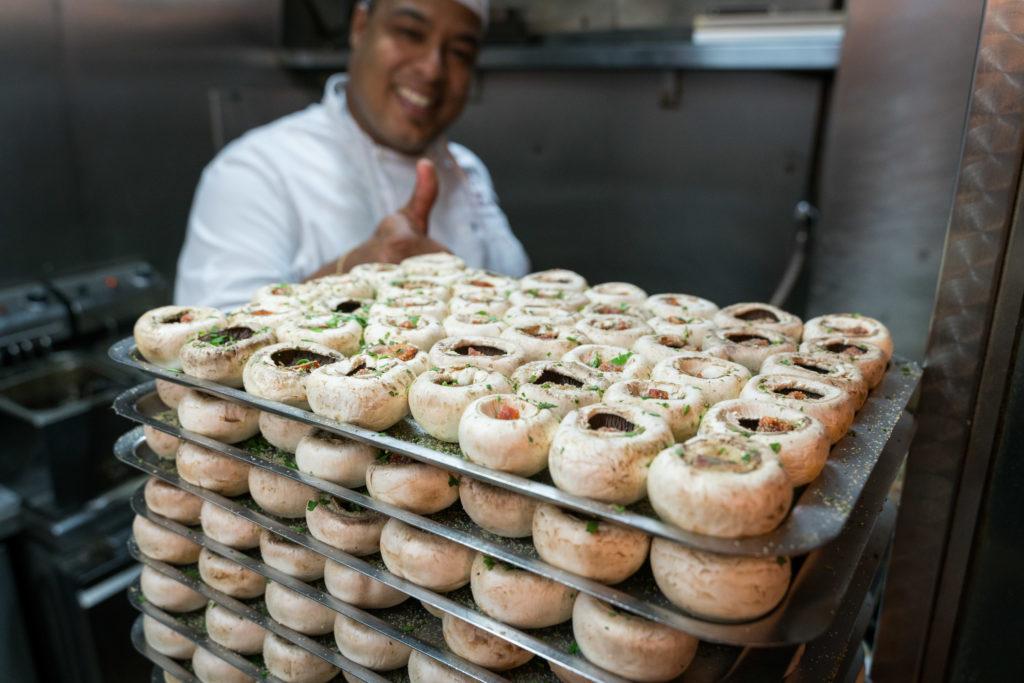
What To Eat in Madrid: Mushrooms @ Meson del champinon
When it comes to what to eat in Madrid, Mesón del Champinon is an essential stop. The Spanish word Mesón is likely derived from the French Maison, meaning house but also related to the original Latin word mansio which has a few meanings as well as being the root for Mansion. But in Spanish, Mesón, in the context of the hospitality industry, means an Inn – so, a bar restaurant that also has some guest rooms too.
So the Mesón del Champinon means the inn of the mushroom. And boy do they have some amazing mushrooms!
This Mesón is located within the exterior of the walls that surround the Plaza Mayor – the main square of Madrid. This grand square was built in the 16th century as a central marketplace. Today it is full of tourist restaurants and it hosts outdoor events.
In the 1960s, when the European tourism boom first started kicking off, a lot of new taverns opened around the outside of the Plaza Mayor walls, including Mesón del Champinon which opened in 1964. So although not ancient, it has certainly become a modern traditional part of the inner city for tapas.
These new inner city Mesons don’t normally feature accommodation, but maintain the food and drink culture of the Inn – the best ones normally with a limited menu of very specific dishes which they are experts in. Though, it’s useful to know that some have been bought out and turned into generic “we sell all types of international meals” type places – which sucks.
At Mesón del Champinon, you walk inside to find small rooms with tables under bare brick arches, supporting the plaza wall. Murals of mushrooms and merriment on the walls. It’s a place to enjoy drinking, and so they claim, the best mushroom in the world. They might be close to the truth on that.
You can order at the counter, right next to the small open kitchen. Stuffed mushrooms are stacked up next to the hotplate. Filled with butter, chorizo, and herbs. They come off the hotplate juicy and delicious, oozing liquid and fat. It’s one of the best tapas in Madrid, so buy a whole plate for yourself!
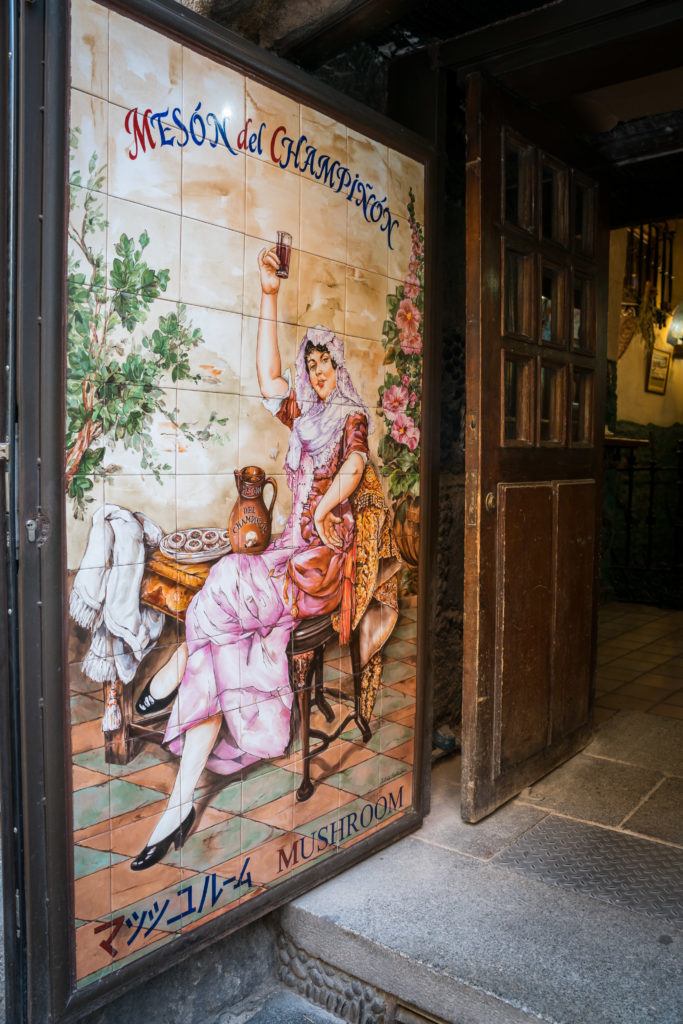 Meson Del Champinon | Madrid Food Tour |
 Exploring the history of Madrid |
As well as the traditional food stops, this Devour Madrid food tour also featured a walking tour of some central historical areas, like the palace and Plaza Mayor. The extra walking can help you feel better about the amount of calories you’ll be consuming.
There are 4 main restaurant stops on the tour, with multiple things to taste at each stop. Get ready for Madrid traditional food like Gambas al Ajillo – shrimp flash fried in olive oil – at a hole in the wall place that claims to have invented the dish in the early 20th century… Did they? We are not sure, but your tastebuds will approve nonetheless.
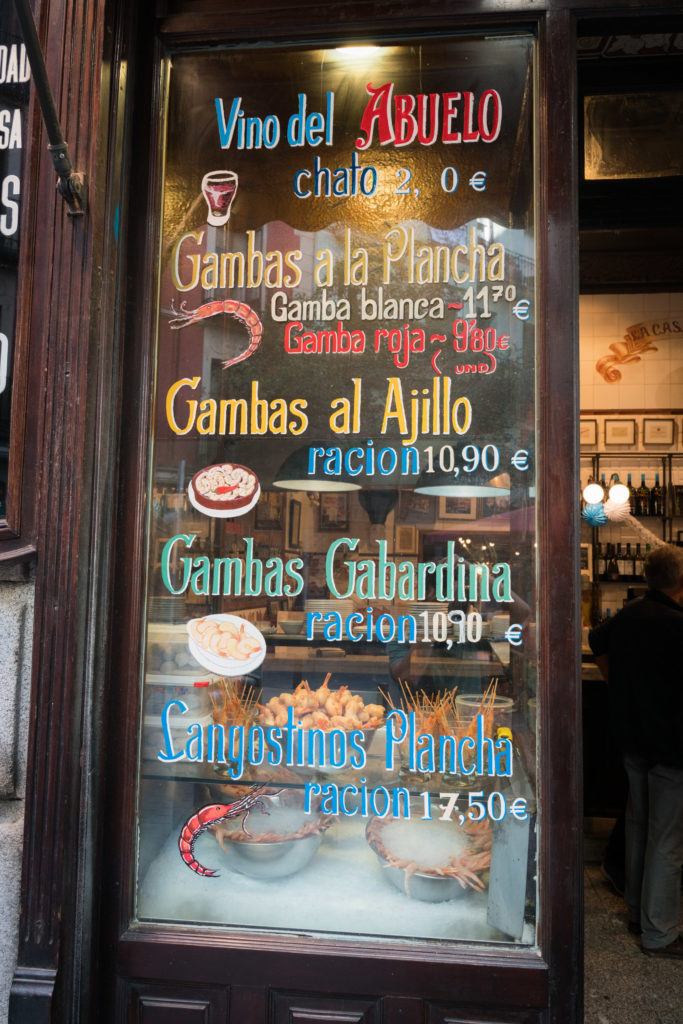 Gambas (prawns) & Langoustines |
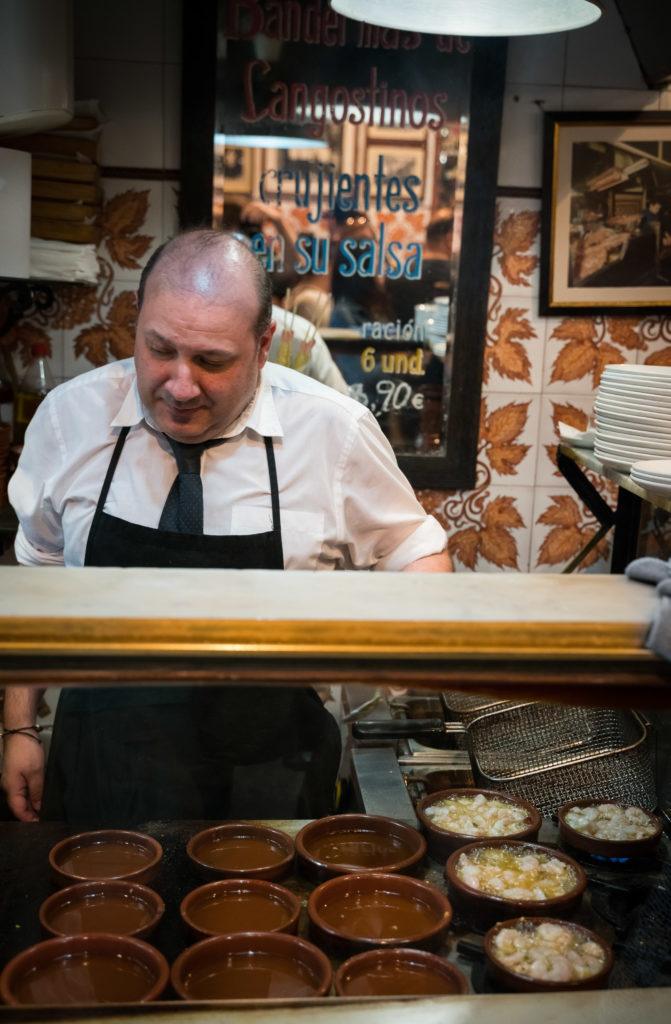 Madrid Food Tour: Flash frying the Gambas |
We took the Devour Madrid tour after having a great time on the Devour Barcelona tour a while back.
We really enjoyed the Madrid tour, the only negative was the last stop was a bit intense for the quantity of food. We can’t complain that we got fed too much, but it was a bit odd that we had croquettas for a second time on the tour (though I actually liked that final round of croquettas more than the first). And they served us a course of tomato stuffed with tuna mayo – not sure how this connects with Madrid traditional food? Would have loved to have tried another typical tapas instead of repeating previous dishes.
But yes, too much food is better than too little when it comes to taking a Madrid Food Tour! We learned a lot, we ate a lot, we left happy.
Book the Taverns, Tapas & History tour with Devour Madrid, or check out some of their other Madrid Food Tours.
What To Eat In Madrid / Madrid Food Guide: Podcast
In This Episode:
- We visit Madrid, The capital of Spain
- We explain the unexpectedly controversial history of Spanish omelette
- Learn why Madrid’s famous stew, Cocido, went from the original dish with no pork to multiple cuts of pork in each dish today.
- Plus, Flamenco meets Haute cuisine. We taste food from a Michelin star chef while watching Spain’s most emotive dance style.
CORRECTION since recording this episode we discovered a more recent edition of the book Culinaria – which we stated as last being published in 2004, but we’ve now seen there is a 2015 edition. It’s still unclear at this time if the original source this book references regarding the history of Spanish omelette is accurate.

Listen & Subscribe: iTunes | Spotify | Google Play | Stitcher
RSS: https://feeds.captivate.fm/thedish/
Support: Become a Patron | Tweet: @foodfuntravel | Email: [email protected]
Tapas Madrid: Snacks, Starters, Street Food & Tapas
Our Madrid Food Guide continues with the must try tapas and Madrid street food options.
Bocadillo de Calamares (Calamari Sandwich)
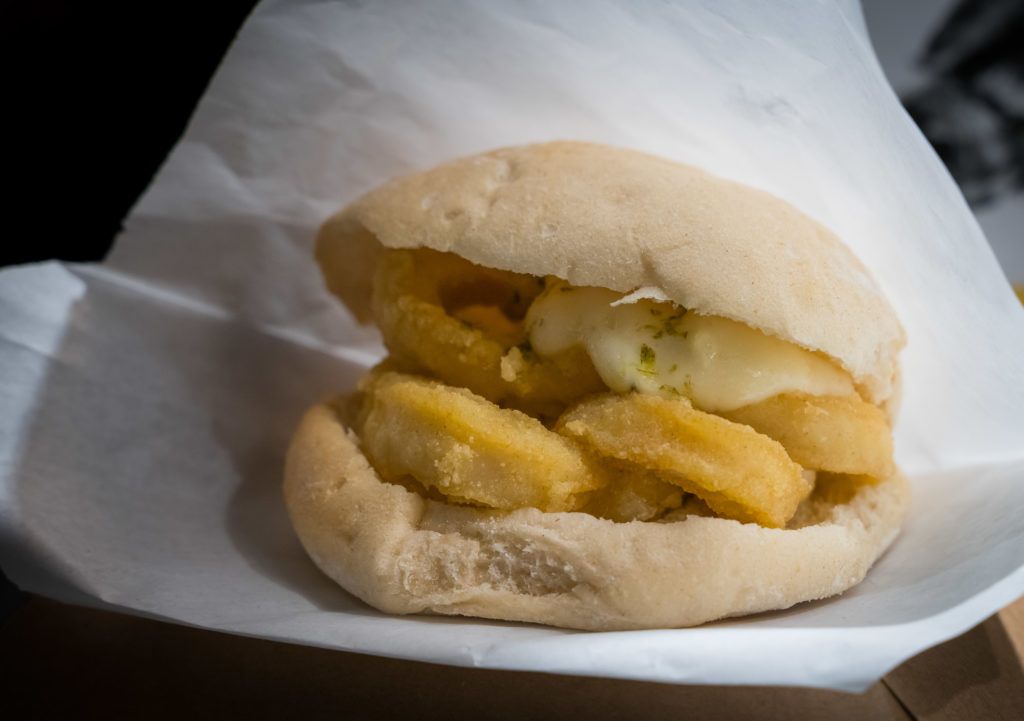
Madrid street food: Bocadillo de Calamares (Calamari Sandwich Madrid)
A Madrid Street Food favorite. Crispy yet succulent calamari, bulked up with bread for a filling lunch on the go. A cheap classic, normally enjoyed with a caña – a small beer.
What To Eat in Madrid: Pimientos de Padrón
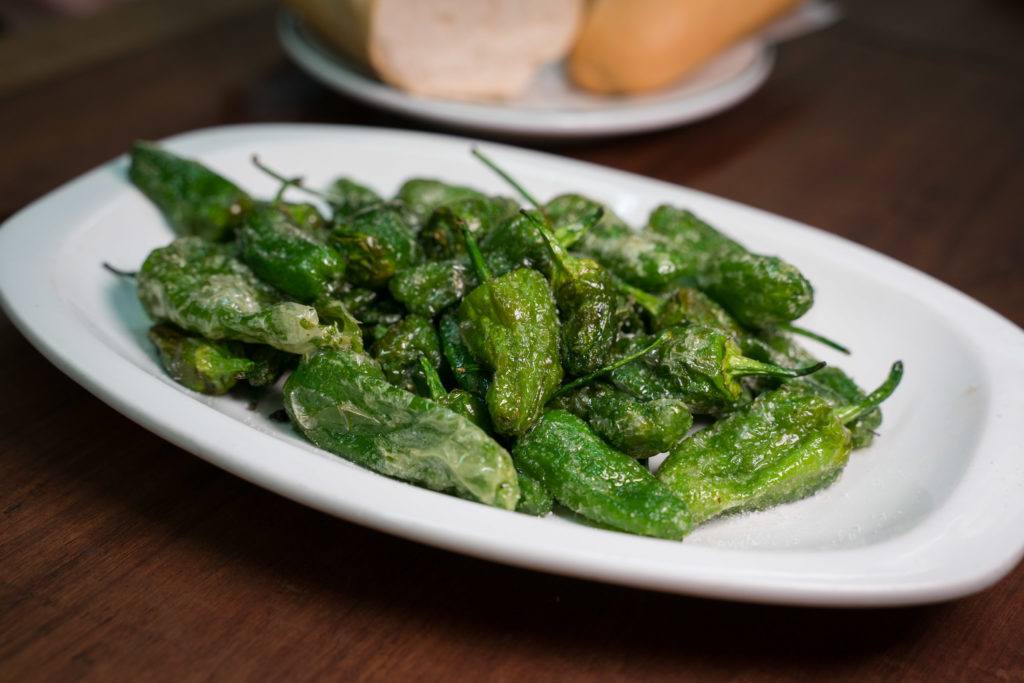
Tapas Madrid: Pimientos de Padrón
Chili peppers, flash fried and then salted. It’s a spicy game of chance as the heat level of each individual pepper varies – depending on how mature they were when picked. The legend goes that the peppers were brought from the Americas in the 16th century to Galicia in North Spain. Monks cultivated them in a monastery close to the town of Padrón after which they are now named.
Tortilla de Patatas / Tortilla Española (Spanish Omelette)
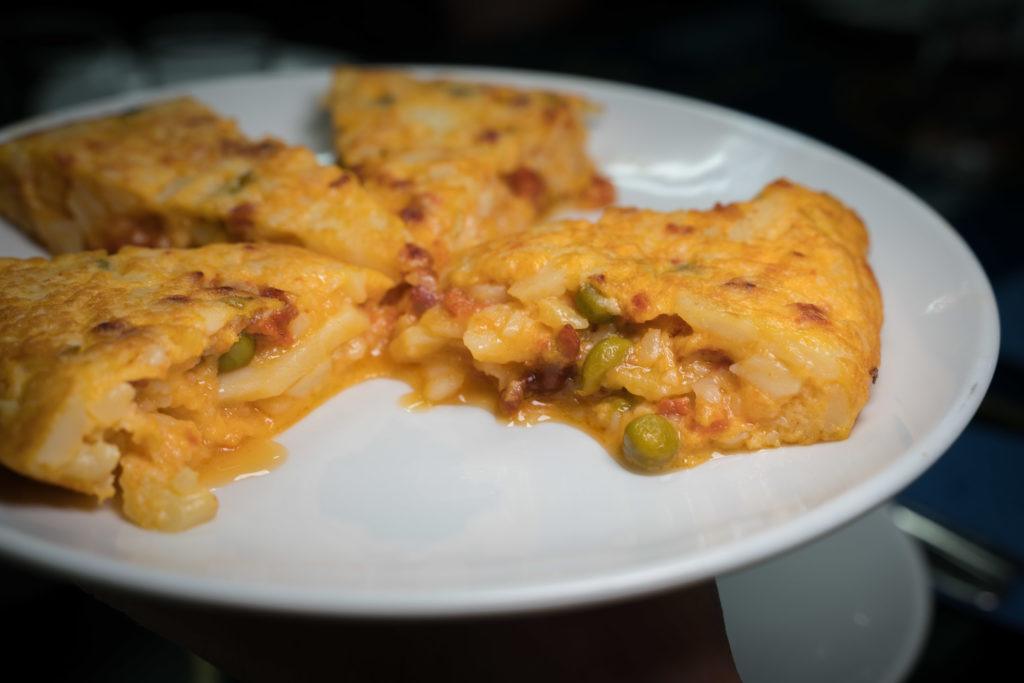
Cheap Eats Madrid: Tortilla de Patatas / Tortilla Española (Spanish Omelette)
A deep dish omelette traditionally made with potatoes and sometimes a few other ingredients. From a dense, fully firm and cold slice you may get in a cafe, to a fresh, hot and runny on the inside tortilla (pictured above) in a local restaurant, to a perfect soufflé like crust but a luxurious, slightly runny and tangy with extra virgin oil premium version.
If done right, The thinly sliced potatoes should be baked literally drowned in olive oil. Then combined with the raw egg and cooked to the desired consistency. A little runny in the middle is the best! But everyone seems to have a preference.
Origins of the Tortilla Española
The origin is very much contested. What we do know is that potatoes made it to Spain around 1570 – so the dish did not exist before that. The first reference to potato being eaten as food in Spain was in Seville at a hospital in 1573.
The most common origin story dates back to 1817 when an anonymous letter was sent to the court of the region of Navarre, to the capital city of Pamplona – of running of the bulls fame. The letter complained that the farmers in the rural areas had so little food they were surviving just from tortilla made from egg and potatoes.
A later story suggests that the dish was invented by General Tomás de Zumalacárregui during the 1835 siege of Bilbao, on the North coast of Spain. He created it as a way to get fast and nutritious food to his troops. Neither of these stories has much definite evidence behind them.
Authors of the 2008 book “The potato in Spain” – Patata en España – claim to have found new documents that show the Tortilla de patata was invented in Villanueva de la Serena (Badajoz), in the south of Spain on Feb 27th, 1798. Created by two land owners, Joseph de Tena Godoy and the marqués of Robledo, in order to find a cheap food to stave off famine in the region.
But was this the first Spanish omelette? The book Culinaria Spain states that the notebooks of the head chef of King Philip III and then king Philip IV of Spain, contain proof that the chef actually created the first Spanish omelette in the late 1500’s – so shortly after potatoes first arrived in Spain.
The chef was Francisco Martinez Montino. He actually published a cookbook in 1611 – Arte de Cozina. It has over 200 recipes in it. He does have recipes for tortillas – but none of those recipes include potato.
Culinaria suggested it was in the chef’s personal notebook, and from a few years earlier than the publication of that cookbook. It’s possible. Perhaps the recipe was not popular at the time so he decided not to publish in his main cookbook? Given how many variations of the same dish he has for both omelette and other dishes, it seems a strange omission.
None of the other recipes in the book contained potato from what I found either. So, where are the secret notebooks? And why is there only one book out there, The Culinaria book, that mentions them? With evidence pre-dating the next competing claim by over 200 years… You’d think that would have been huge news in the Food history community, for such an important cultural dish.
It’s all a bit iffy. Until this lost notebook can be produced, it seems like the 1798 claim is the first documented evidence, the dish may have been created in many different places, and long before, but the landowners in Villanueva de la Serena are getting the win for now.
Meson de Champinons

Best Food In Madrid: Mushrooms @ Meson de Champinons
The legendary mushrooms filled with chorizo – as discussed above in the Madrid Food Tour section. For what to eat in Madrid, these are a must.
Jamón ibérico (Iberian Ham)
There is ham and then there is Jamón ibérico. It’s a big step up from Serrano ham, and you’ll see this high end pork delight sometimes selling for over 200 Euros per Kilo. Jamón ibérico is made only from pigs that roam large areas of woodland, and are fed premium ingredients. The pinnacle being 100% acorn fed pigs.
The cured ham is sweeter and less salty than it’s cheaper counterpart, Serrano. It dissolves on the tongue like a cloud made of pork, sent from heaven.
Tapas Madrid: Croquettas (Croquettes)
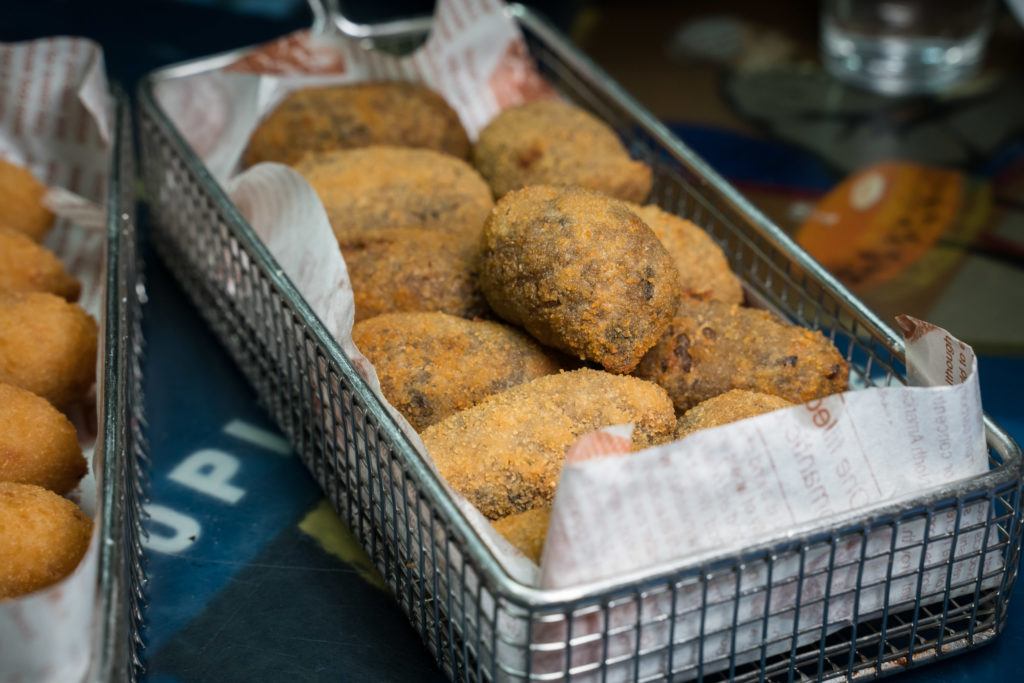
Tapas Madrid: Croquettas (Croquettes)
Croquettas are an essential Madrid tapas that you’ll find on every tapas bar menu. Deep fried potato balls, the mashed potato mix is combined with some other ingredients. Jamon (Spanish ham) is probably the most popular. Mushroom croquettas are also a Madrid Street Food favorite.
What To Eat In Madrid: Tostas
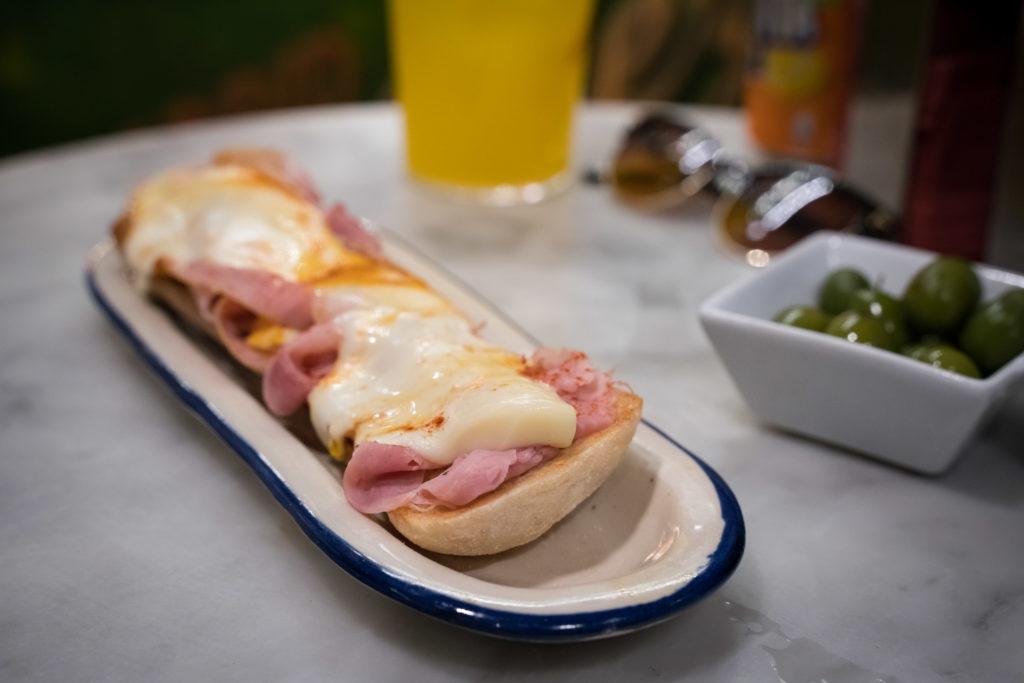
What To Eat In Madrid: Tostas
One of simplest yet most versatile tapas in our Madrid Food Guide. Things on toast is tostas. You can’t go wrong with anything cheese or pork related, of course. But there is a huge sheer variety to discover around Madrid.
Oreja a la Plancha (Grilled Pigs Ear)
Pigs ear, cartilage and all, grilled with olive oil. A salty, porky beer snack for those with slightly more adventurous tastes. A slightly unusual food to try in Madrid.
What To Eat In Madrid: Gambas al Ajillo (Garlic Prawns)
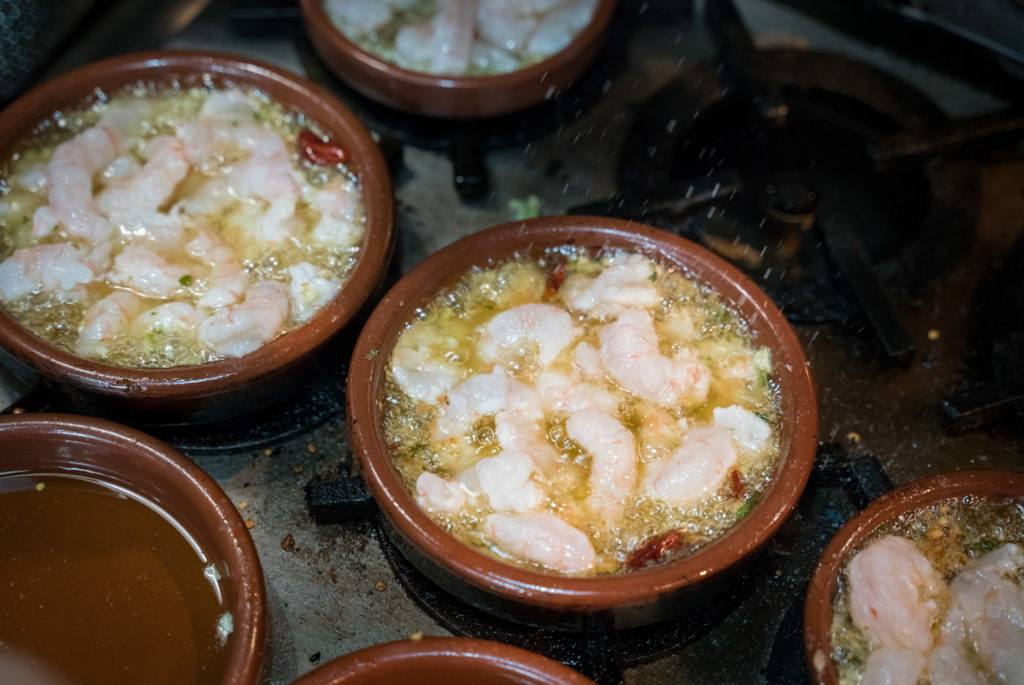
What To Eat In Madrid: Gambas al Ajillo (Garlic Prawns)
One of Madrid and Spain’s most popular tapas. Simply, prawns flash fried in plenty of olive oil and garlic. This plus some bread to dip = magic.
Patatas Bravas
Next in our Madrid Food Guide: Potatoes with a spicy bravas sauce. The ways in which the potatoes are cooked, or the sauce is made, vary wildly. You never quite know what you are going to get but it always fills a food whole. A famous food in Madrid and all over Spain.
Boquerones (Pickled Anchovies)
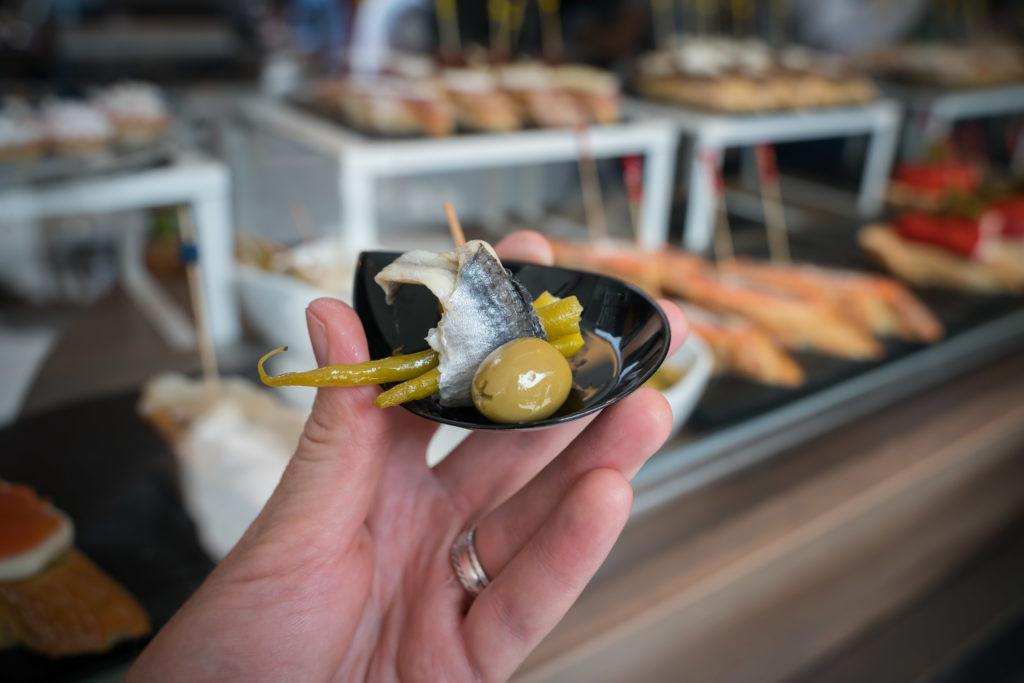
Tapas Madrid: Boquerones (Pickled Anchovies)
Pickled anchovies. Much firmer than the salty and grainy little anchovies you seem to get on pizzas. It’s a completely different taste with a pleasant hit of sourness. Perfect on their own with olive oil, but you’ll also find Boquerones used for many other dishes, like on tostas.
Soldadito de Bacalao (Cod Fritters)
Little pieces of salt cod, battered and deep fried. A simple but popular food to eat in Madrid.
What To Eat In Madrid: Empanadas
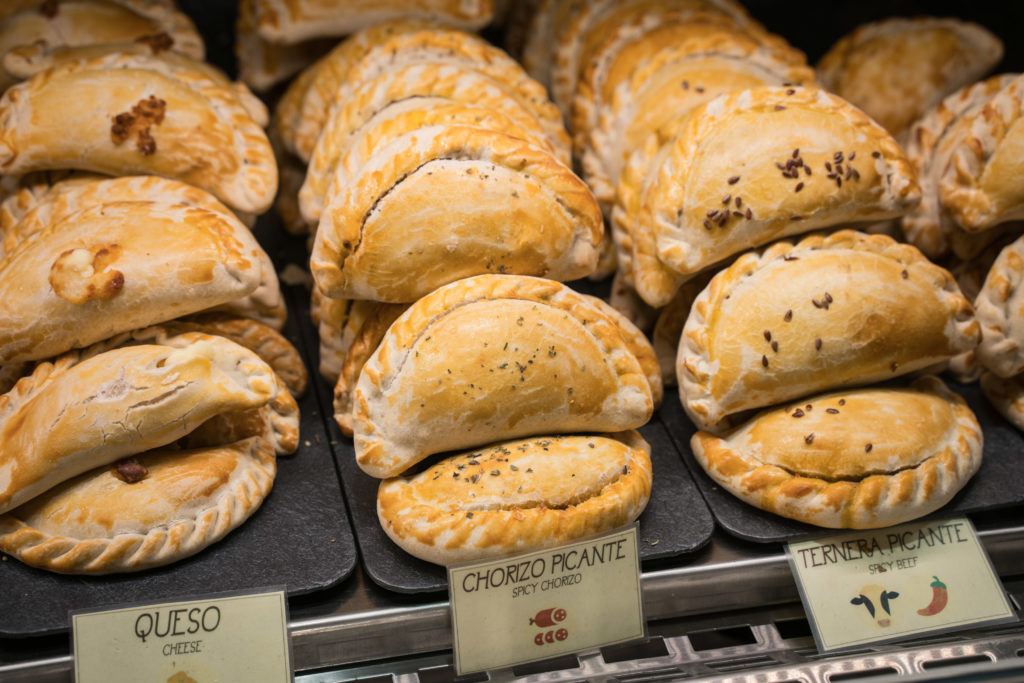
What To Eat In Madrid: Empanadas
Spanish style crimped pies. Oh, so many fillings! A famous food in Madrid, Spain, and all over Latin America.
Huevos Rotos (Broken Eggs)
Not just for breakfast. Huevos rotos are a tapas staple in Madrid. Fried eggs are broken and then normally served on top of fried potato. definitely not scrambled eggs, think of them more as a sloppy cook purposely messing up your fried eggs in the best possible way.
Madrid Accommodation (Opens In New Tab): Booking.com | Agoda | Hotels.com | Airbnb (Get $25 Credit)
Support our blog by booking your Madrid accommodation through our links.
Madrid Food Guide: Hearty Dishes / Mains
Next in Our Madrid Food Guide – some bigger, heartier dishes.
What To Eat In Madrid: Cocido Madrileño

Cocido Madrileño. This image was originally posted by tnarik at https://www.flickr.com/photos/80075387@N00/414019810. It was reviewed on by FlickreviewR and was confirmed to be licensed under the terms of the cc-by-sa-2.0.
Cocido Madrileño is Spain’s everything stew. A famous food in Madrid where a multitude of ingredients are all thrown into water and then simmered for a long time. This sort of cooking style has been around since ancient times and has evolved independently all over the world.
Though ingredients used may vary, Cocido Madrileño always features chickpeas (Garbanzo beans). It always features meat, traditionally multiple forms of pork such as pork bones, pork knuckle, Bacon or ham, chorizo, Morcilla, sometimes chicken or veal or beef too. It’s really a whatever meat you have situation, though at least one type of pork should always be used, more on why later.
Then later in the process, vegetables are added too – perhaps potatoes, carrots, cabbage or whatever else is available.
After boiling all the chickpeas, meat and veg together, the stock is separated and used to cook up some Spanish noodles. Specifically, the short thin noodles. The noodle soup is then served as a first course, with the chickpeas and veg as the second course and the meat as the third course. Though sometimes the meat and veg may come together.
Cocido was always a home cooked meal, but today busy modern life means locals want it from restaurants, especially in the winter as it is a very hearty dish. Thursday is known as the best day to find Cocido as a menu del dia – menu of the day – in a lot of places.
But what are the origins of Cocido Madrileño?
Although the ancient history of boiling meat and veg together is impossible to trace. The distinct version of Cocido Madrileño seems to have originated in the 15th century.
Cocido Madrileño was probably adapted from the Sephardi Jewish dish in Spain called Adafina which in turn is likely a regional variant of Cholent, a traditional Jewish dish that was first documented in 1180 AD.
Though the dish was almost certainly being made before 1180 AD, it’s cooking style was specifically designed to conform with Jewish laws that prohibit cooking or lighting a fire on the Sabbath. Originally, meat, veg, and beans would have been set cooking on Friday night and then left to cook overnight and eventually keep warm on embers until Saturday morning. Then it could be eaten after the morning religious services.
The Jewish laws, as well as ways to cook without breaking them, would of course have been passed between communities. Spanish Sephardic Jews originated in the Iberian peninsula, having taken that name since the second century AD. Not to be confused with Sephardic jews of the middle east.
Though the dish Cholent may be the older variety, the Adafina in Spain is closer to Cocido Madrileño, being made with chickpeas, rather than beans. It differs in that it would use whole boiled eggs, instead of pork, and spices like cinnamon, allspice, and ginger.
It was from 1478 when things started to change. The Spanish inquisition, who no-one expected at the time, started running around forcibly converting Jews. To prove they had truly converted, they started to add pork to their adafina. Eventually, new names were used for the dish, presumably to distance the cooking from being Jewish.
The dish spread all around Spain and Portugal, some using beans rather than chickpeas. Though it is also likely that versions popped up independently as Jewish communities throughout the region had to adapt their cuisine.
Carrillada de Ternera (Beef Cheeks)
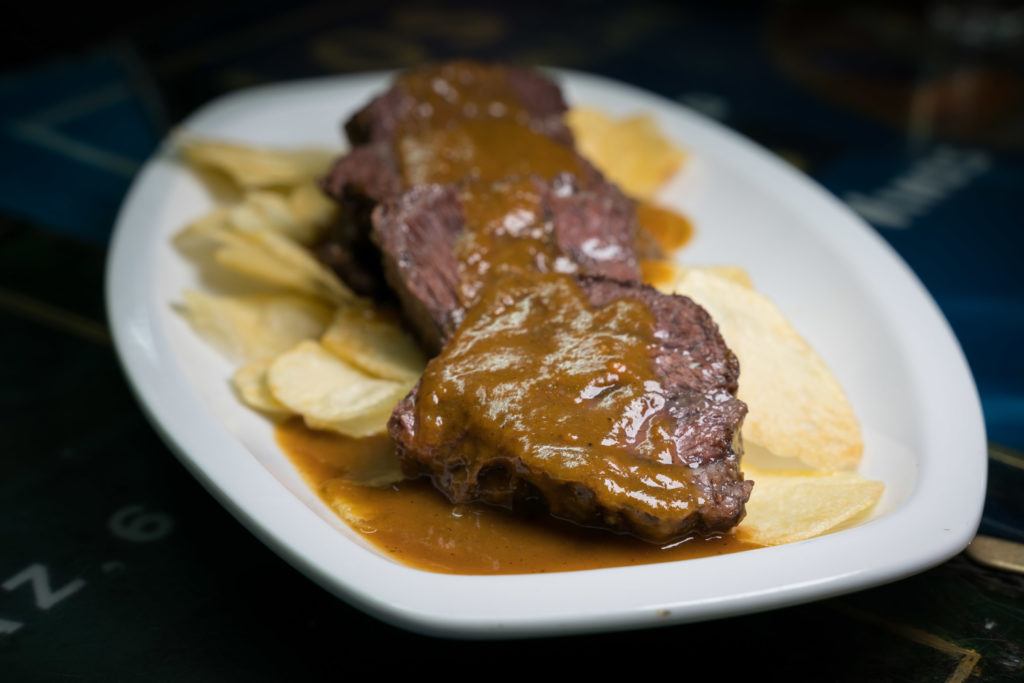
What To Eat In Madrid: Carrillada de Ternera (Beef Cheeks)
Carrillada is cheeks and in Madrid cuisine, both beef cheeks (Carrillada de Ternera) and pork cheeks (Carrillada Ibérica or Carrillada de Cerdo depending on how fancy the pork is) are popular. The meat is braised to get it melt-in-the-mouth soft. Often served in a wine sauce but there are lots of recipes out there to explore.
Callos Madrileños (Tripe Stew)
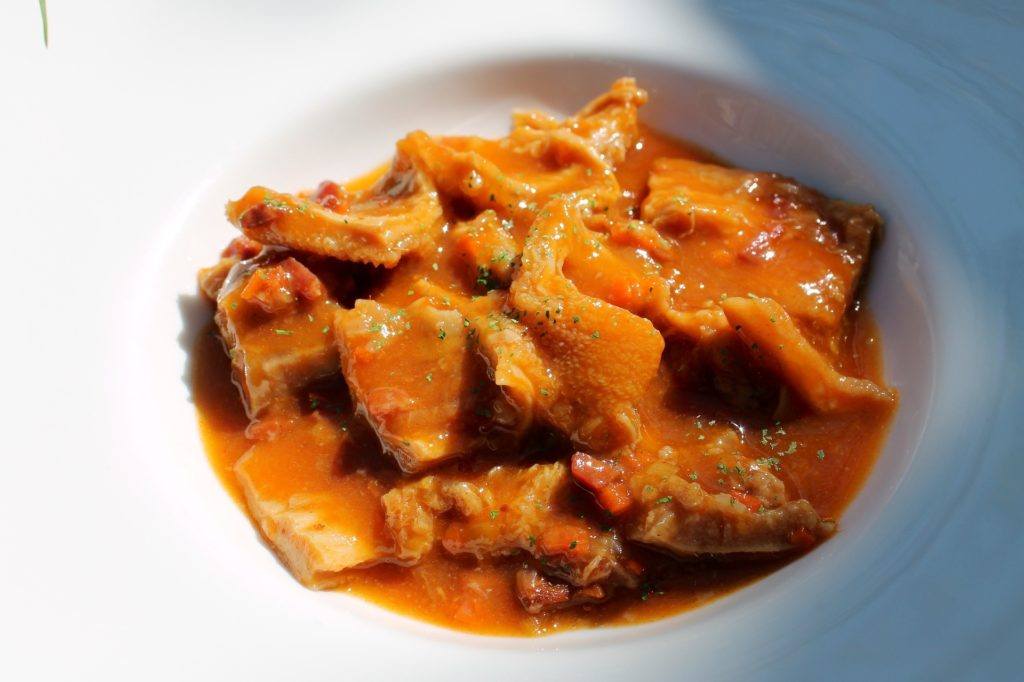
What To Eat In Madrid: Callos Madrileños (Tripe Stew)
Callos Madrileños is one of the more unusual things to eat in Madrid – though still popular with locals. For lovers of offal, you’ll find this winter dish offering up tripe flavored with morcilla (blood sausage) and chorizo. This smoky paprika stew has been doing the rounds in tavernas around Madrid since the 16th century.
Cochinillo Asado (Suckling Pig)
Whole roasted baby pig. Where to eat in Madrid? Sobrino de Botín – they have a Guinness world record for being the oldest continuously operating restaurant in the world, since 1725. They specialize in the Cochinillo Asado.
Pimientos de Piquillo Rellenos (Stuffed Piquillo Peppers)
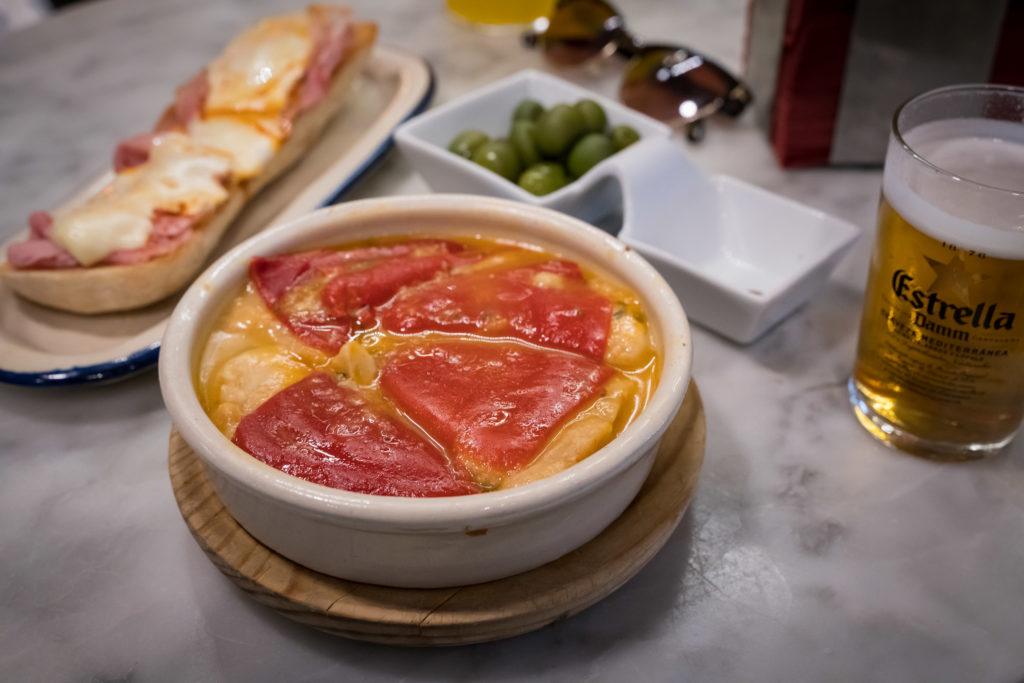
Best Food in Madrid: Pimientos de Piquillo Rellenos (Stuffed Piquillo Peppers)
Stuffed peppers are popular all over the world. Piquillo peppers are traditionally grown in Northern Spain near the town of Lodosa. They are 100% sweet, with no heat at all. The version pictured, stuffed with a blended pate of salt cod and prawns – served hot. Amazing.
What To Eat In Madrid: Sweets, Desserts & Drinks
Our Madrid Food Guide moves to the sweeter side of the menu… Desserts in Madrid & traditional drinks.
Desserts in Madrid: Torrijas (Spanish Style French Toast)
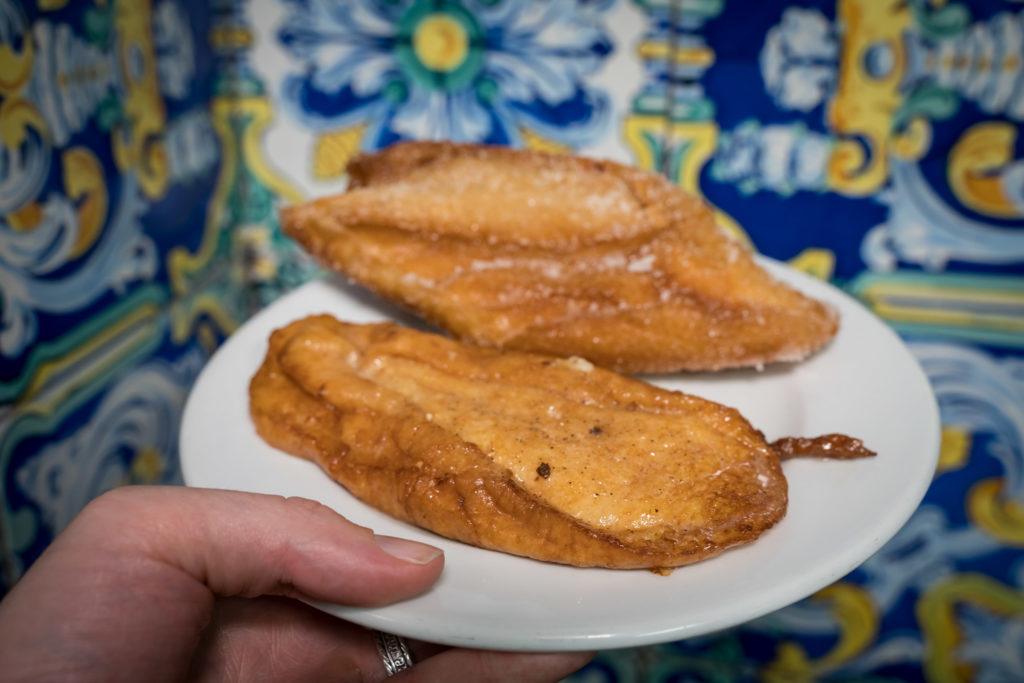
Desserts In Madrid: Torrijas (Spanish Style French Toast)
The smart way to use up old bread. The bread is soaked in a milky egg mixture, then fried. Torrijas are traditionally eaten during the Easter period but at La Casa De Las Torrijas in Madrid, they serve them all year round. They even do some alternative varieties, like one soaked in wine. Though I think the classic version is still the best.
Desserts in Madrid: Churros con Chocolate (And Porras)
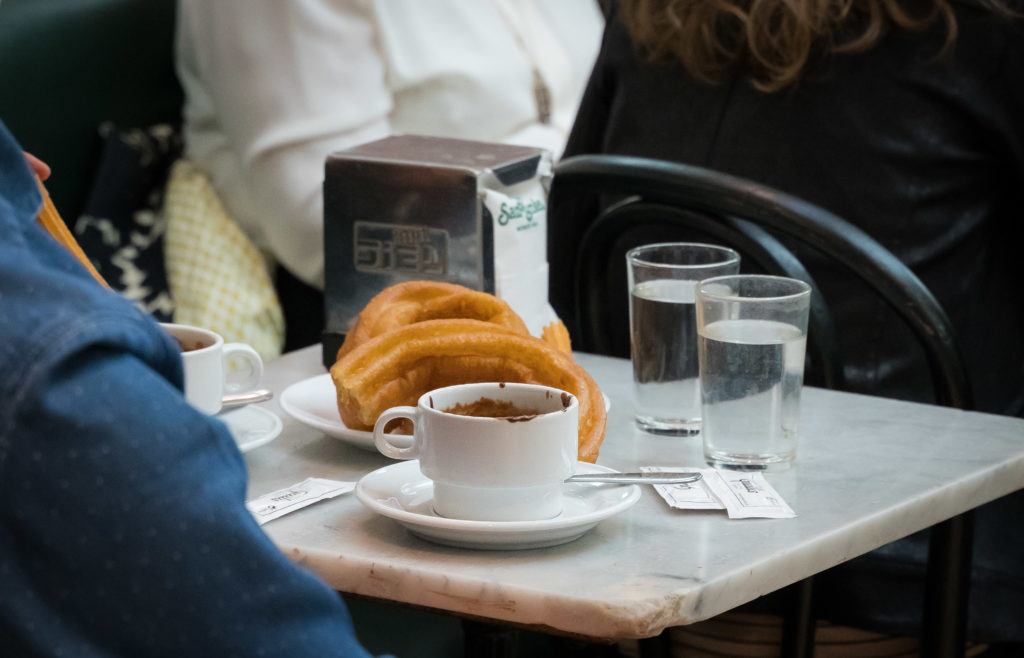
Desserts in Madrid: Porras con Chocolate
The world famous fried dough sticks. Churros are long and thin and often folded into a horseshoe shape. In Madrid, it’s also popular to eat porras (pictured) a thicker version of churros. Dipping them in thick hot chocolate is a popular pastime. You’ll find specialized churros con chocolate cafes like Los Artesanos 1902, in Madrid.
Was the Churros invented in Spain? We’ll be delving deep into the story of Churros in a future podcast episode. Coming Late 2019.
Traditional Drinks: Vermut (Vermouth)
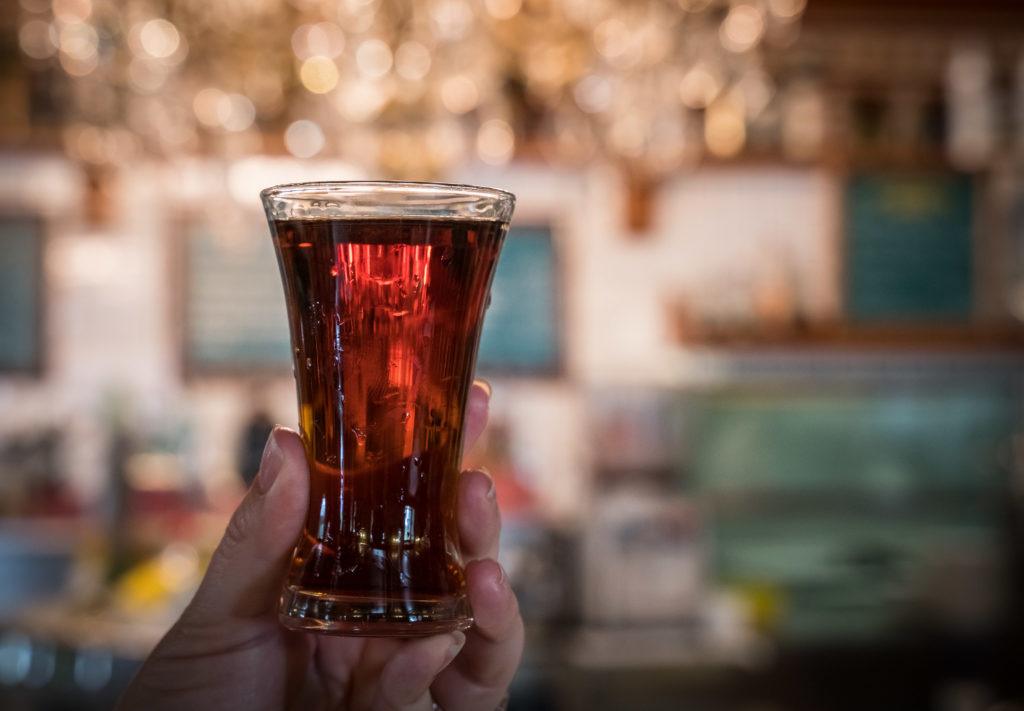
Madrid Food Guide | Traditional Drinks: Vermut (Vermouth)
Unlike its Italian cousin, Spanish Vermut has a more artisanal production and is often made in unique blends at each individual vermut bar in Madrid. It’s a blend of wine with a lot of botanicals. The Spanish version is typically less bitter than the Italian dry vermouth.
It turns out that Vermouth has a long and winding history, possibly dating back to ancient Greece. We’ll be digging deep into the history of Vermouth in an upcoming podcast. (Coming September 2019)
Tinto Verano

Madrid Food Guide | Tinto Verano (Summer Red Wine)
Tinto Verano is summer red wine. It’s a simple combination of red wine with either soda – like Fanta limon (lemon fanta), or sprite, 7up or just soda water and some lemon juice or lemonade. It’s the perfect light summer drink for enjoying on a sun drenched terrace. A lighter, simpler alternative to sangria.
—-
That’s it for our Madrid food guide. Now you know what to eat in Madrid, go out and find some Madrid traditional food and enjoy!
Love This Post? Pin It For Later
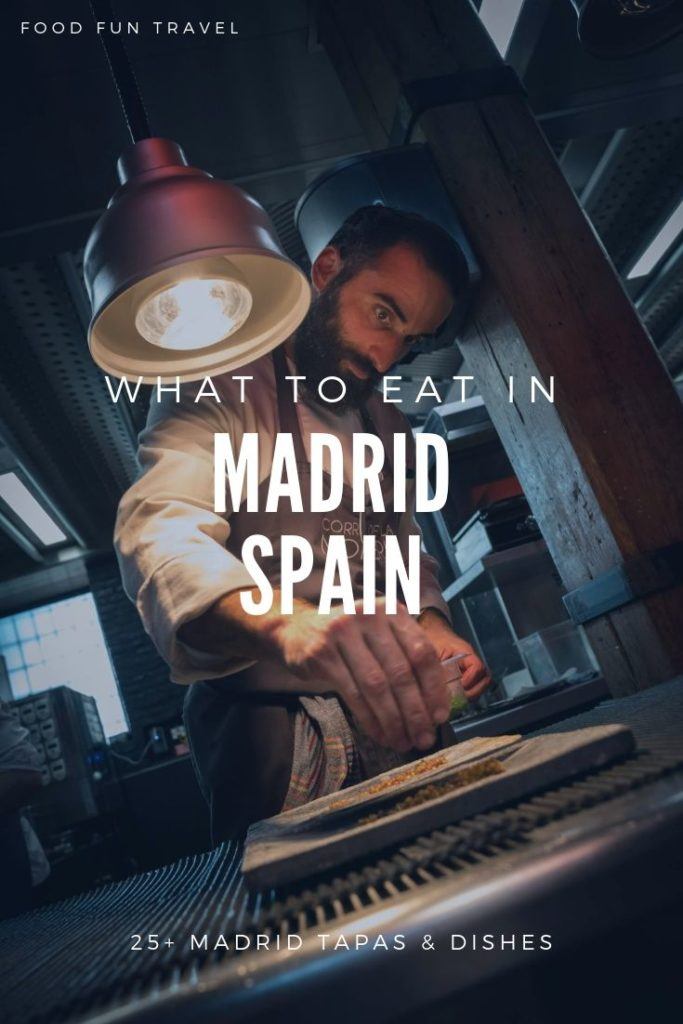 |
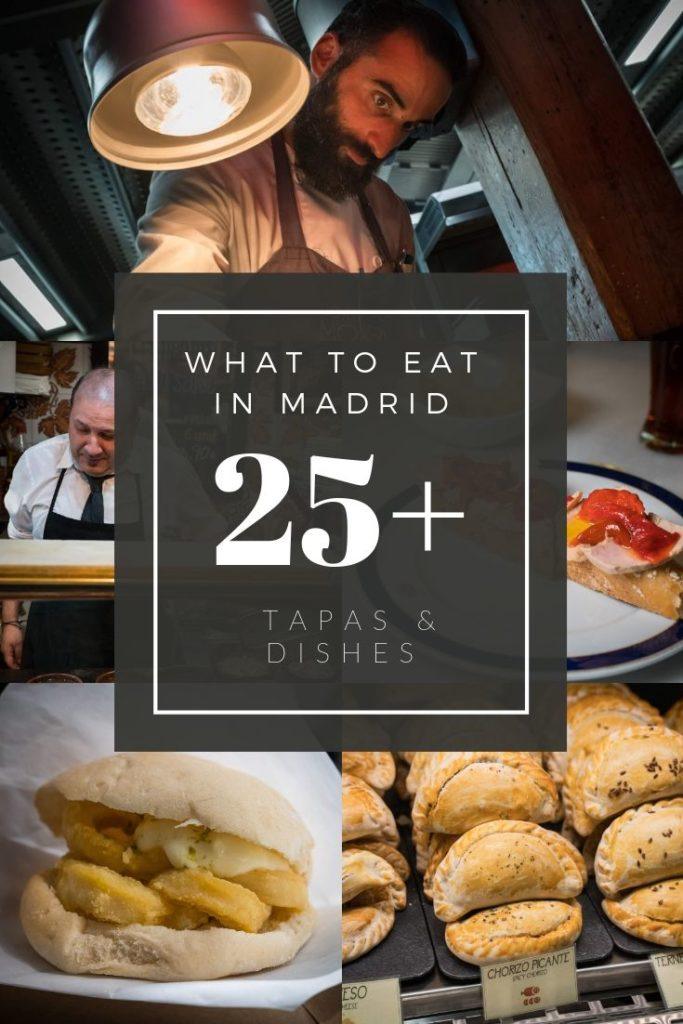 |
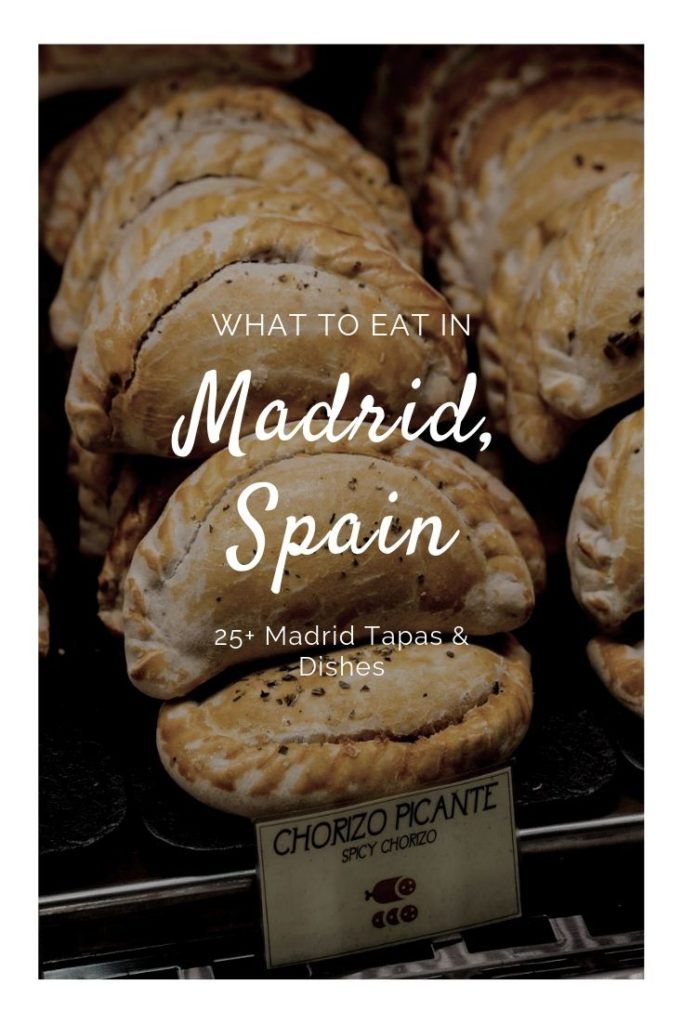 |




